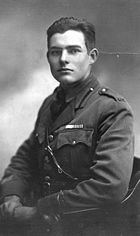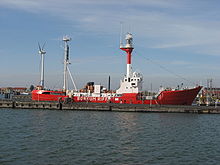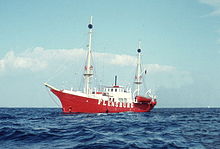The lightship
The lightship is a story by the German writer Siegfried Lenz . It is the cover story of a volume of short stories published by Hoffmann and Campe in 1960 . The action takes place on a lightship , where there is a conflict between the crew and a gang of fugitive gangsters. There is no consensus among the crew members about the type of resistance. In particular, the captain and his son hold opposing views and fall apart.
The realistic narrative contains typical features of a novella and is often understood as a parable on the topics of violence , resistance and the responsibility of the individual. It is one of Siegfried Lenz's best-known works and is anchored in the curricula of numerous schools. The original was filmed three times.
content
On a lightship anchored in the Baltic Sea , which is about to be decommissioned, a conflict arises between the small crew and a gang of gangsters. The captain of the lightship, Johann Freytag, takes the criminals, whose boat broke while trying to escape, on board as supposedly castaways. When the armed gang, led by a man named Caspary, threatens the crew, the captain initially lets them go, so as not to put anyone in danger. For the same reason, he also refuses to hand over the only lifeboat that the crew depends on in an emergency. Because of his indulgence, Freytag has to assert himself against some members of his crew who want to take the gunmen off guard. In particular, his young son Fred accuses the father of cowardice.
The gangsters demand to be brought ashore with the lightship itself, but the captain refuses to do so because the lightship has to maintain its position at sea in order not to endanger shipping. Caspary manages to win over some crew members through threats and bribery. When the crew gathers to raise the anchor, the captain calmly approaches the gangsters despite warnings until he is struck down by a shot in the stomach. His son then stabs the shooter to death and the crew intervenes, overpowers the gangsters and hands them over to the police. Fred eventually comes to understand and respect his father's attitude.
shape
According to Hans Wagener , the story Das Feuerschiff can be read as an exciting crime story , but on its 100 pages it also obeys the classic definition of a novella . The group of people is limited, an “unheard of incident” is told that is heading towards a turning point. The eponymous ship can be understood as a thing symbol that stands for order on the sea. Paul Dormagen described Das Feuerschiff as "probably the most convincing example that the novella is still possible today." The structure is also reminiscent of a classic drama with the presentation of place and time in an exposition , the complication with the inclusion of the castaways, the climax and the periphery with Freytag's refusal to give in to the gangsters' demands, the retarding moment of the various disputes on board up to the catastrophe including resolution of the conflict, Freytag's confrontation with the bandits and their overcoming.
The story has two narrative levels; the scenic sequence of the present is flanked by Freytag's and Caspary's two reports from the past. There is no commentary narrator, the reader has to take a position on the questions raised. The style is realistic but not naturalistic . The dialogues are not in the boatmen's Low German, which is to be expected , but in High German that creates a distance . Walter Jens described the dialogues as “concise, unpathetic, not very nuanced, the people speak the language of the author.” The language is generally “apparently indifferent, factual, very cold and very precise”, determined by technical terms, the so-called “technical terms ". Jens characterized the course of action: "No loud words, no great pathos , no lingering on the action highlights, no psychology : the situation determines the behavior of Lenz's characters."
interpretation
Hans Wagener sees two themes linked in the story, which ultimately lead to a common solution: on the one hand the conflict of order and chaos between the ship's crew and the gangsters, on the other hand the father-son conflict between Freytag and Fred. The opponents in the conflict between order and chaos, between good and evil are the captain Freytag and the lawyer Dr. Caspary. The latter's criminal career is based on a philosophical foundation, according to which every person is guilty of a crime and thus open to blackmail. In fact, there is also a dark point in Freytag's previous life, his failure to help a comrade imprisoned in the Levant . Nevertheless, Freytag remains steadfast against Caspary's attempts at bribery.
The father-son conflict goes back to Freytag's unresolved past and is sparked by his current tolerance of criminals, which his son accuses him of cowardice. In the two generations there are two opposing principles: the heroism of the son, who prefers death to life under the shame of cowardice, and the utilitarianism of the father, who seeks to minimize the risk and condemns hasty acts as senseless martyrdom . But Freytag does not avoid the risk in order to shirk his responsibility; on the contrary, he risks his life at the moment when more than his own reputation is at stake, namely when the hijacking of the ship threatens the safety of shipping as a whole. In contrast to his son, courage and bravery are not values in themselves for him, they must have a meaning that points beyond the fate of the individual. In the final conversation between father and son, Fred learned to understand his father's actions and motives, and he assures the captain that “everything is in order”, which relates not only to the restored order on board the ship, but also to the resolved conflict between father and son. It remains to be seen whether the captain will survive his injury.
The exemplary character of the narrative and its self-contained setting, reminiscent of an experimental laboratory, give the story the exemplary character of a parable . The story becomes a general political allegory on the themes of violence and resistance , responsibility , tolerance and their limits. The motifs allow numerous references to historical or current political conditions. Marcel Reich-Ranicki described that "a parabolic basic situation [...] is authenticated by epic means". "It's about anarchy and order, about passive and active resistance , about the responsibility and guilt of the individual, about his behavior in a collective threatened and ultimately dominated by terrorism ." Ulrich Plüddemann saw The Lightship in general as a parable, "in the the effects of different behaviors in a crisis situation are shown or discussed. ”Just one year later, Siegfried Lenz dealt again with the question of the responsibility of the individual in his play Time of the Innocent .


In the story Das Feuerschiff there is also an argument between the author and his literary teacher Ernest Hemingway . Fred's youthful idealization of bravery and the heroic moment still follows in the footsteps of the American Nobel Prize winner, who was formative for Siegfried Lenz's literary development. In the end, however, they are overcome by the reason and serenity of the captain, the opposite of a Hemingway hero. Herbert Lehnert described: “The captain is something of an anti-Hemingway character. […] The plot is basically to dissuade the captain's boy from the Hemingway ideal of brave existence ”. Manfred Durzak recognized in the "actionist theatrics" and the "modeling pathos" still clear influences of Hemingway's 1937 novel haben und nichthaben . For Winfried Baßmann, on the other hand, the story Das Feuerschiff marked the beginning of a new creative period in the work of Siegfried Lenz. Lenz's confrontation with Hemingway repeated in another story from the band The Lightship The titles of the beginning of something parody of Hemingway's Nick Adams story The End of Something alludes.
reception
Walter Jens judged the story Das Feuerschiff in the year it was published : "That's what I call mastery: inventing a calculated, exciting story and telling it so confidently that the reader only realizes at the end: the fable actually serves to characterize the background - how easily the community of the occupation disintegrates, how resolutely the son turns against his father, how fluid are the boundaries between adventure and crime. "From Hermann Boekhoff's point of view, Lenz had written his best story to date with the" extensive story [...]. "
Marcel Reich-Ranicki criticized the “terrifying preference for reasoning and moralizing” of the main character. He was bothered by a few “concessions” in scenes “whose drama must at best be regarded as not very demanding”, and located the Kuhl brothers in a “fund that an author like Lenz should not reach”. But his conclusion was: “Nevertheless, Das Feuerschiff is rightly one of those works that have cemented Siegfried Lenz's literary reputation.” Hermann Wiegmann found that the story Das Feuerschiff “is also well suited for use in school lessons - overall Manageable and concentrated with very individually drawn characters and a structure that promotes tension. ”The story soon found its way into school curricula in the 1960s and has been an integral part of German lessons ever since.
Siegfried Lenz himself wrote about the genesis of his story: “From my window I can see the fire-red hull of a lightship far out on the bay: a point of approach for shipping, a symbol of security that has grown to the ground [...] I tried to create a conflict between unarmed and armed power on the lightship. "According to Rudolf Walter Leonhardt , Lenz had reached a climax that he could no longer exaggerate with his approach of" imagining situations and turning them into stories full of symbols. "
Adaptations

Just three years after the story was first published, it was filmed for the first time in 1962 by the director Ladislao Vajda under the same name . In the leading roles Dieter Borsche played as helmsman Rethorn, James Robertson Justice as captain Freytag, Michael Hinz as his son Fred and Helmut Wildt as Caspary.
A film based on the narrative called The Lightship was also released in American cinemas in 1986. Directed by Jerzy Skolimowski , the best known actors were Tom Bower , Klaus Maria Brandauer , William Forsythe and Robert Duvall . The lightship Fehmarnbelt in front of Sylt served as the backdrop .
In 2007, the NDR produced a contemporary adaptation of the material as a television film Das Feuerschiff , which was first broadcast in 2008, for television under the direction of Florian Gärtner . Jan Fedder plays the role of Captain Freytag, Axel Milberg that of the gang leader Caspary. Siegfried Lenz himself appears as an angler in a cameo . The plot was filmed on the lightship Borkumriff IV in the North Sea , which has now been used as a museum ship .
On December 7, 2017, a monodrama directed by Nicola Bremer and dramaturgy by Svenja Käshammer premiered at the Dresden State Theater. Jannik Hinsch played all roles.
First edition
- Siegfried Lenz: The lightship. Narratives . Hoffmann and Campe, 1960.
Secondary literature
- Hermann Boekhoff: The lightship . In: Westermanns Monatshefte , Heft 3, 1960, pp. 88–90.
- Hans Wagener : Siegfried Lenz: The lightship. In: Stories of the 20th Century. Interpretations Volume 2 . Reclam, Stuttgart 1996, ISBN 3-15-009463-1 , pp. 82-92.
Web links
- Reading commentary by Karin Pohle on the Ernst Klett Verlag website (pdf; 109 kB)
- Press kit for the NDR television film from 2007 (pdf; 2.0 MB)
Individual evidence
- ^ A b Hans Wagener: Siegfried Lenz: Das Feuerschiff. P. 83.
- ^ Paul Dormagen: Handbook on modern literature in German lessons. Hirschgraben, Frankfurt am Main 1967, p. 347.
- ^ Hans Wagener: Siegfried Lenz: Das Feuerschiff. Pp. 83-84.
- ↑ a b Walter Jens : The background in Siegfried Lenz . In: The time of December 16, 1960.
- ^ Hans Wagener: Siegfried Lenz: Das Feuerschiff. Pp. 84-86.
- ^ Hans Wagener: Siegfried Lenz: Das Feuerschiff. Pp. 86-89.
- ^ A b Hans Wagener: Siegfried Lenz: Das Feuerschiff. P. 91.
- ^ A b Marcel Reich-Ranicki : Siegfried Lenz, the serene confidante - 1963 . In: Colin Russ (ed.): The writer Siegfried Lenz . Hoffmann and Campe, Hamburg 1973, ISBN 3-455-06368-3 , p. 226.
- ^ Ulrich Plüddemann: The novels of Siegfried Lenz . Dissertation, Stellenbosch 1972. Quoted from: Hagen Meyerhoff: The figure of the old in the work of Siegfried Lenz . Peter Lang, Frankfurt am Main 1979, p. 215.
- ^ Hans Wagener: Siegfried Lenz: Das Feuerschiff. Pp. 89-90.
- ↑ Herbert Lehnert: The form of the experiment as a parable. A few things about Siegfried Lenz . In: Frankfurter Hefte 18 (1963), p. 480.
- ↑ Manfred Durzak: The German short story of the present. Author portraits, workshop discussions, interpretations . Königshausen & Neumann, Würzburg 2002, ISBN 3-8260-2074-X , p. 219.
- ↑ Winfried Baßmann: Siegfried Lenz. His work as an example of the way and location of literature in the Federal Republic of Germany . Bouvier, Bonn 1976, ISBN 3-416-01271-2 , p. 56.
- ^ Hans Wagener: Siegfried Lenz: Das Feuerschiff. P. 90.
- ↑ Hermann Boekhoff: The lightship . In: Westermanns Monatshefte , Heft 3, 1960, p. 90.
- ^ Hermann Wiegmann : The German literature of the 20th century . Königshausen & Neumann, Würzburg 2005, ISBN 3-8260-2972-0 , p. 290.
- ↑ Preliminary remark on the main topic: Contemporary literature in German lessons . In: Communications of the German Association of Germanists . June 1990, p. 3.
- ↑ Quoted from: Kenneth Eltis: Siegfried Lenz and politics . In: Colin Russ (ed.): The writer Siegfried Lenz . Hoffmann and Campe, Hamburg 1973, ISBN 3-455-06368-3 , p. 85.
- ↑ Rudolf Walter Leonhardt : Time notes. Criticism, polemics, feature pages. Piper, Munich 1963, p. 224.
- ↑ Das Feuerschiff (1963) in the Internet Movie Database .
- ↑ Das Feuerschiff (1985) in the Internet Movie Database (English).
- ↑ Das Feuerschiff (2008) in the Internet Movie Database (English).
- ↑ The lightship. Staatsschauspiel Dresden, accessed on May 7, 2018 .

